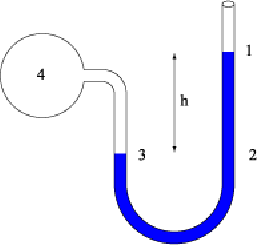Manometers measure pressure.

It is basically a glass tube closed at one end, the other end open to the atmosphere. The closed end contains a gas, separated from the atmosphere by liquid in a 'U' bend, shown in blue above. The gas in the bulb exerts a pressure,![]() and pushes the liquid around the U bend until forces on the surfaces of the two surfaces of the liquid are useful.
and pushes the liquid around the U bend until forces on the surfaces of the two surfaces of the liquid are useful.
The gas in the bulb 4 exerts a pressure![]() We calculate the force exerted on the surface using the equation
We calculate the force exerted on the surface using the equation
![]()
so the force exerted on the left hand liquid surface 3 by the gas is![]()
This force must be balance by an equal and opposite force exerted at 2 by the atmosphere and the liquid. The atmosphere exerts a pressure equally in all directions, of about![]() so using (1) again, the pressure exerted by the atmosphere is
so using (1) again, the pressure exerted by the atmosphere is![]()
To find the force at 2 we must add to this the force exerted at 2 by the column of liquid between 1 and 2. The pressure exerted by a column of liquid of height![]() is
is![]() where
where![]() is the density and
is the density and![]() so the force exerted by this column of liquid is
so the force exerted by this column of liquid is![]() using (1) again.
using (1) again.
Equating forces at 3 and 2 gives
![]()
If the mass and temperature of gas in the glass bulb is kept constant, a manometer can be used to measure atmospheric pressure. If the gas is pumped out so that there is a vacuum in the bulb then![]() The liquid in the U bend will move towards the bulb end and the pressure exerted by the liquid will be useful to atmospheric pressure.
The liquid in the U bend will move towards the bulb end and the pressure exerted by the liquid will be useful to atmospheric pressure.